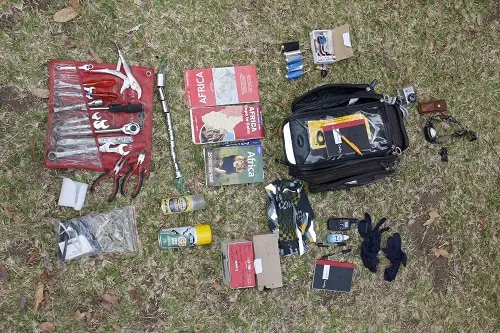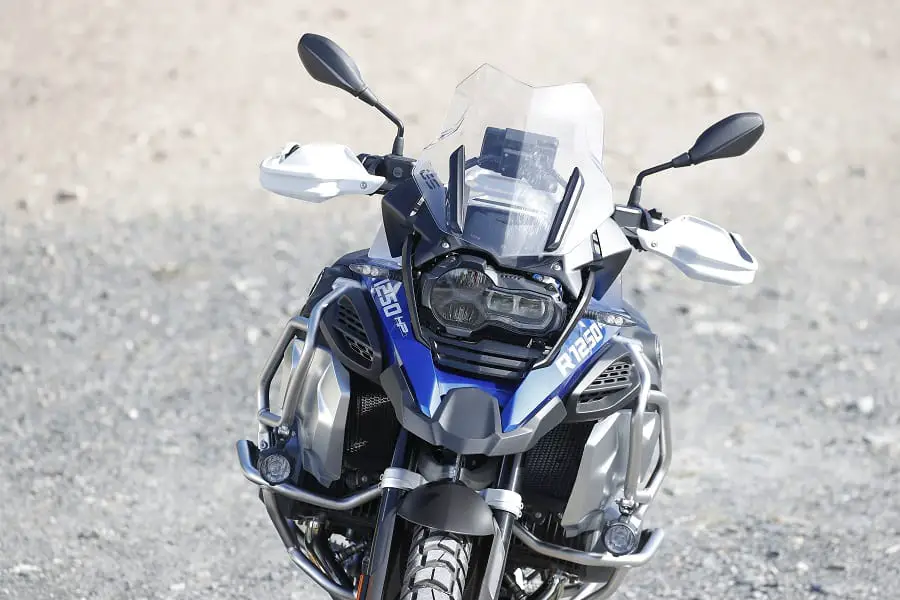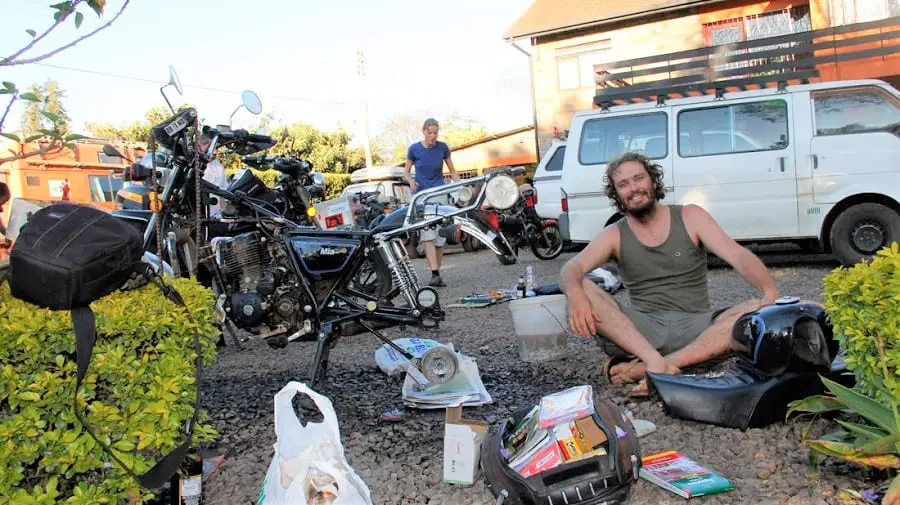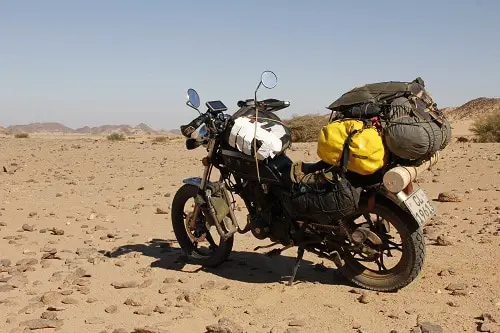So you’ve taken the plunge and purchased an adventure bike. You can’t wait to start touring and are busy making a list of what else you need. While you don’t need much to get out there and explore the world, there is a plethora of adventure bike accessories to make your trip more enjoyable.
We’ve made a list of the 24 most useful accessories you can buy for your cross continental adventure bike trip.
1. Wider foot pegs
Riding an adventure bike often requires standing up or at least distributing the weight from one foot peg to the other. The narrow OEM foot pegs can become uncomfortable after long periods of standing up. Adventure riders also wear large boots, similar to motocross racers. If the pegs are too narrow it may be difficult to grip onto the pegs.
The solution is replacing the standard pegs with wider aftermarket steel foot pegs. They have grooves on top to prevent your boots from slipping. The larger area reduce the pressure on your feet by distributing your weight over a bigger surface. These pegs simply bolt onto the attachment points of the OEM pegs.
2. Spot lights
While the golden rule of adventure biking is to never ride after sunset, it is inevitable to happen at some point on a trip. A puncture or breakdown might see you riding at night to reach the next campsite. Extra spotlights that are brighter than the bike’s high beam will improve visibility significantly and make night riding a lot safer. You will be able to spot obstacles, like a deer in the road, much earlier.

LED and HID/Xenon lights draw less electrical current than traditional Halogen bulbs and shine brighter, but they are more expensive. Your choice of spot light will depend on your budget and the spare capacity of your bike’s electrical system. Spot lights are typically available in two forms: (1) wide beams that illuminate the side of the road, or (2) narrow beams that shine further ahead.
3. 12V electrical socket
Having a 12V charging socket on your bike is very handy. You can charge your phone or action camera, or plug in your GPS if it is not wired straight to the bike’s battery. This handle bar mounted 12V socket is easy to install on any motorcycle and has an inline fuse, which is very important in case of an electrical short.
4. Motorcycle GPS and bracket
A GPS is very useful on an adventure bike trip. Apart from the obvious navigation capabilities, it will also show you how far the nearest gas station or ATM is. You can load updated software, like Track2Africa (depending on where you are heading) which will show the best accommodation in the area and what to watch out for, like police check-points and permanent speed cameras.
The Garmin Zumo XT has a large 5.5 inch touch screen that you can operate with a gloved finger, is water resistant, and has a very bright screen to make it visible in direct sunlight. This specific model is voice activated too if you pair it with your Bluetooth helmet.
A mounting bracket will have to be purchased separately if not included. It is easily mounted to your bike’s handlebar and wired (with a fuse) directly to the battery.
5. Bash plate
The most vulnerable part of you adventure bike is the underside. Apart from debris flying up from the road, you can hit a tree stump or hidden rock when riding in a dry riverbed. A bash plate made from aircraft grade aluminium, that wraps around the engine block, provides the best protection for your engine and oil cooler.
Most aftermarket bash plates like this one (for the BMW F800 GS) can easily be installed yourself by simply bolting onto the frame.
6. Tank bag
For the price, a tank bag must be one of the best value for money accessories you can take on a long adventure bike trip. They come in different sizes and can easily be zipped open while riding. It is perfect to stow small tools and items that you use often.
Some tank bags like this one attach to the bike’s steel fuel tank with magnets and have a transparent pouch for a map. A water proof cover can be quickly drawn in case it starts to rain. I managed to fit all my tools for a 3-month African bike trip in my tank bag.

7. Handlebar raisers
Depending on your bike and body type, handlebar risers can make for a more comfortable riding position for your neck, shoulders and wrists. Higher handlebars make riding standing up easier, so if you plan on riding off-road a lot it may be worth a look.
Just remember that your bikes’ brake, throttle and clutch cables might not be long enough to accommodate too much lift. Usually, a 30 mm riser is suitable for most models without needed to modify the cables.
8. Tire pump
Of all the breakdowns you can experience on an adventure bike trip, a flat tire is probably the most likely one. You will need a tire repair kit for tubeless tires, or a spare tube for tube-type tires. Make sure you know how to fix the tire yourself. Once the tire is fixed, you will need a pump to inflate it.
There are various options you can take on your bike, from a cheap bicycle hand pump or CO2 cartridge kit, to a 12V mini air compressor. For more detail, go and read this article on motorcycle pumps. A 12V tire pump is the easiest option.
9. Crash bars
Most adventure bike manufacturers offer crash bars as optional extras or standard equipment on some models. If your bike does not have a set, it might be worth it. Crash bars prevent damage to the fuel tank (and your legs depending on how you fall) and is a convenient place to mount spot lights and tools (you can cable tie tire irons and tubes to it). A bike with crash bars are also easier to pick up after a tumble, as the bike is not completely flat on the ground.

The downside of crash bars, apart from the price, is that they are heavy and may block the bolts that hold your side covers on. That means removing the crash bars to get to certain parts of the bike when servicing it. Crash bars transmit the energy of a crash directly to the frame. While it may seem like a positive, it increases the likelihood of damage to the frame instead of simply the side covers and tank.
10. Valve removal tool
For a couple of dollars a set, slotted head valve stem caps are a must. Just replace your plastic valve caps with these as soon as you can. They are used to remove the valve core when deflating a tire completely when you want to remove it, or to replace a leaking valve core. By using these caps you won’t lose the little tool and they are always with you on the bike.
In additional to being a useful little tool, they won’t perish and let dirt in like plastic valve caps.
11. Center stand
Most modern adventure bikes come out with center stands in addition to side stands. They are invaluable if you need to remove a wheel to fix a puncture or to adjust the chain.

The center stand bolts onto the frame of your bike and a strong spring retracts it when you push the bike off of it.
12. Hard or soft luggage
On short trips, or if you are not camping, you might get away by simply strapping a back-pack to your rear saddle or the OEM luggage rack. But if you are riding two-up or if you are camping on an extended adventure bike trip, you will need more substantial luggage options.
You’ve got a choice between hard or soft luggage. With hard luggage boxes (plastic or aluminium) you will need a luggage rack that bolts onto the frame of your motorcycle. Many adventure bike manufactures offer this as an optional extra and there are numerous aftermarket racks available too. If you opt for soft saddle bags like these, you don’t need a luggage rack. You can simply through it over the saddle and tie it to the frame. A luggage rack will, however, protect your bike’s side panels from wear.
Hard luggage has the advantage of being waterproof, secure and it will protect the contents during a fall. If it breaks, however, you may not be able to fix it on the side of the road. Soft luggage is lighter and can be tied to the bike in the event of damage due to a crash.
13. Bike to Bike communication
When riding in a group or with a pillion it is convenient to be able to chat with one another while riding. The most common option are Bluetooth intercoms attached to your helmet. Some helmets have Bluetooth already integrated. Two-way radios can also be used, but you will need an interface between the radios and your helmet.
For more detail on the different options of bike to bike communication systems, check out my article here.
14. Hand guards
Not all bikes come with hand guards. Apart from looking cool, they protect your hands from branches overhanging the trail. It is also very useful in the cold weather. It is amazing what difference it makes in the freezing cold, even if you are wearing gloves with inner linings. You don’t need full hand guards, simple wind deflectors will also work.
15. Helmet lock
If you want to avoid carrying your expensive helmet everywhere you go, like the gas station rest room or the grocery store, get a simple helmet lock. They are cheap and it is not worth it risking leaving your helmet on the bike or in your tent.
16.Luggage straps
You may wonder why I didn’t include this under luggage, but the right type of straps can save you a lot of frustration. I’ve found these Rok Straps so useful that I will never go on a trip without them. They are very durable and super easy to use. The two sections of the strap are attached independently around a luggage rack, frame tube or foot peg carrier. The luggage is then placed between the attachment points, the two parts of the strap are buckled together, and the strap is tightened.
After many years mine still shows no sign of wear or being stretched.
17. Hydration pack
When riding for hours on end, especially in hot temperatures or on demanding dirt roads, it is important to stay hydrated. If you don’t want to stop every hour to have a drink of water, a hydration pack is a must. You can store snacks and other small items (like your wallet or phone) in the pockets and drink water from the tube attached to the bladder inside.
On our Cape to Cairo bike trip I had my Camelbak with 1.5 litres of water on the front and a back-pack on my back for 90 days straight without any discomfort.
18. Chain cleaner
Your motorcycle chain needs regular maintenance if you want it to be reliable on a long adventure bike trip. Maintenance includes cleaning the chain, especially after riding in very dusty conditions. A chain brush works very well to remove most of the dirt and grime. Simply put your bike onto its center stand and brush the chain as it rotates in neutral (or first).
For a complete article on how to service your chain on an adventure bike trip, check out my post here.
19. HEX GS-911 diagnostics tool for BMW
If you ride a BMW GS and often venture far from the nearest big town, you might be interested in the HEX Gs-911 diagnostic tool. It plugs into the diagnostics plug of most BMW motorcycles and gives you greater insight into what’s going on inside your motorcycle. You will be able to read the fault codes on your laptop or smart phone whilst you are out in the sticks. Even if you cannot fix the problem yourself, it might help a back yard mechanic fix the issue by knowing where to look.
While not cheap, it may just give you that extra peace of mind if you are worried about venturing too far into the unknown.
20. Heated grips
Heated grips are not only comfortable in freezing weather, but safer too. Warm hands react quicker. Most modern adventure bikes have heated grips as a factory option, like the BMW R 1250 GS or KTM 1290 Super Aventure R. On the new Honda CRF 1100 L Africa Twin ES it is a standard feature. Even on older, more primitive bikes you can install an aftermarket heated grip kit like this.
The optional heated grips on the BMW R 1250 GS is equipped with high-precision sensors that measure the outside temperature. The “intelligent” two-level adjustable heated grips then automatically regulate the heat level of the grips via the onboard computer.
21. Luggage net
While I would never advise you to rely only on a luggage net to fasten your luggage, it is very useful to throw over as a secondary support. It is cheap enough to buy and I’ve found it handy for those light, loose items that you want to get to quickly (like my flip flops). I usually tie the heavy luggage with Rok Straps and pull the luggage net over the whole lot.

22. Smart phone bracket
If you don’t have a GPS and want to use Google Maps on your mobile phone to navigate, a handlebar mounted smart phone bracket is what you need. There are many different types, from a basic grip to a waterproof casing with charging ports connected to your bike’s electrical system. You can also listen to music from your phone with wired or Bluetooth earphones.
23.Seat pads
Long days in the saddle may result in a lame ass, literally. The seats of some bikes are more comfortable than others, but after a 10-hour ride you will notice it regardless of which bike you are riding. Luckily you’ve got some options to increase the plushness of your ride. You can get an air cushion like this or a Sheep Skin Buttpad like this. Yes, that is what they call it! It apparently makes a good camping pillow too and is not affected by rain.
24. Throttle lock
To give your right-hand wrist a brake now and then, cruise control is a great feature. Most older bikes do not have cruise control, but we are starting to see it more and more on more modern adventure bikes. For an article on which new adventure bikes comes standard with cruise control, see this post.
If your bike doesn’t have cruise control, a throttle lock kit is an option. With your thumb you can lock the throttle in position to give your hand a brake. It won’t maintain the engine or road speed, but will keep the throttle from returning to the closed position. Opinions in rider forums on the safety of these systems are varied.
Conclusion
The list above is by no means exhaustive and none of the accessories mentioned are 100% necessary in order to have a successful and fun adventure bike trip. In the end it is not about the equipment you take but the memories you make.
I always suggest to go on your first bike trip with what you have. On the trip, make a list of things that you think would have made it more enjoyable and buy it before the next trip. It is so easy to buy a bunch of stuff that you don’t need and it just ends up filling the garage.
Fill up your tank and get out on the trials!

